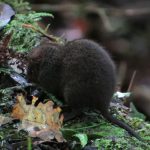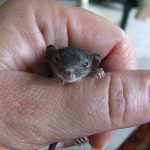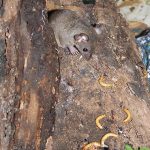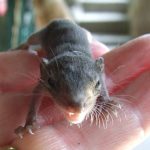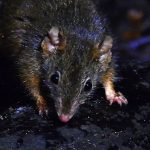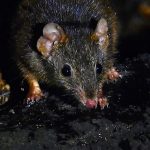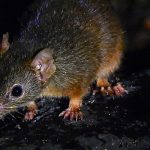ANTECHINUS
Nature’s Most Energetic Mammal
A Tale of Mistaken Identity
Deep within the tangled forests of Northern New South Wales, a small, quick-footed creature weaves through the leaf litter beneath the ferns. At first glance, the Brown Antechinus could be mistaken for the common house mouse. Its pointed nose, rounded ears, and soft brown to dusky fur create a familiar silhouette scurrying across the forest floor. But beneath this resemblance lies a world of difference.
What Makes the Antechinus Unique?
Unlike feral mice, 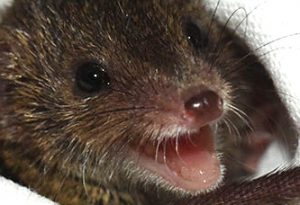 the Antechinus lacks the strong odour and large incisor teeth that rodents use for gnawing. Instead, it is equipped with sharp, canine-like teeth ideal for its carnivorous diet.
the Antechinus lacks the strong odour and large incisor teeth that rodents use for gnawing. Instead, it is equipped with sharp, canine-like teeth ideal for its carnivorous diet.
This dasyurid marsupial does not chew cables or raid the pantry. Instead, its preferred fare consists of insects such as cockroaches, spiders, and small lizards. With its sharp, inquisitive eyes and quick, darting movements, the Antechinus scours leaf litter and crevices for the faintest tremor of insect life. This makes it a valuable ally in balancing the ecosystem and helping with insect control in bushland areas. On rare occasions, if an Antechinus is present in or near your home, it may also provide natural pest control. By respecting the small predators in our midst and preserving their habitats, we play a part in supporting the intricate balance of Australia’s unique ecosystems.
| Feature | Antechinus | Feral Mouse |
|---|---|---|
| Teeth | Canine-like, sharp | Large incisors, for gnawing |
| Odour | None | Strong, musky |
| Diet | Insects, lizards | Seeds, grains, stored food |
| Behaviour in Homes | Rare | Common |
The Wild Drama of Antechinus Mating
Each September, forests in Eastern Australia become the stage for one of nature’s most astonishing spectacles. The Brown Antechinus, Dusky Antechinus, and Yellow-footed Antechinus all follow a similar script. Male Antechinus enter a fervour, their only purpose to find and mate with as many females as possible.
Mating Rituals: A Race Against Time
For up to six hours at a time, males engage in uninterrupted mating—a feat they repeat with multiple partners across two intense weeks. This biological marathon comes at a cost: driven by stress and exhaustion, every adult male dies shortly after this single breeding season.
Did you know?
The Antechinus has been called the world’s most sexually active mammal.
The Mother’s Journey: Survival Against the Odds
One month after mating, female Antechinus give birth to 7-10 tiny young, so small they can barely cling to their mother’s teats in her open pouch. For 5-8 weeks, the mother continues her foraging, her newborns dragged gently through the moss and undergrowth, enveloped by the scents of earth and leaf litter. Eventually, when the young become too heavy, she leaves them safely concealed in a soft, dry nest inside a hollow log.
Growth and Independence
- 3 months: Young are weaned and begin exploring with their mother.
- As summer ends: Each Antechinus becomes solitary, ready to face the wild alone.
- 11 months: They reach sexual maturity, and the cycle begins anew.
The Dusky Antechinus: Life in the Mountain Understory
In the cool, shaded valleys and dense thickets of ferns along the East coast and Tasmania, the Dusky Antechinus shines as a specialist forager. Its strong limbs and sharp claws dig into the earth for beetles and worms, occasionally plucking a ripe blackberry from the brambles. The understorey is alive with moist scents of moss, cracked bark, and rich soil—the Dusky’s preferred hunting ground.
- Habitat: Mountainous forests with dense vegetation.
- Diet: Primarily invertebrates, sometimes fruits.
Conservation Message
While not endangered, the Dusky Antechinus faces challenges where habitat loss and burning destroy its undergrowth shelter. Protecting these forests ensures the future of not only Antechinus, but countless other native species that share this environment.
Living Alongside Wildlife
Before setting a mouse trap in your home, consider the quiet presence of native species like the Antechinus. Their role in pest control and maintaining healthy forests is vital. Careful identification and wildlife-friendly pest management help protect these unique creatures—guardians of Australia’s biodiversity.
Beneath the surface of Australia’s forests, life unfolds with drama, tenderness, and resilience. The Antechinus, though small, reminds us of nature’s complexity and the responsibility we share in protecting it for generations to come.
Photo Gallery
Yellow-footed Antechinus by Sharon McGrigor


